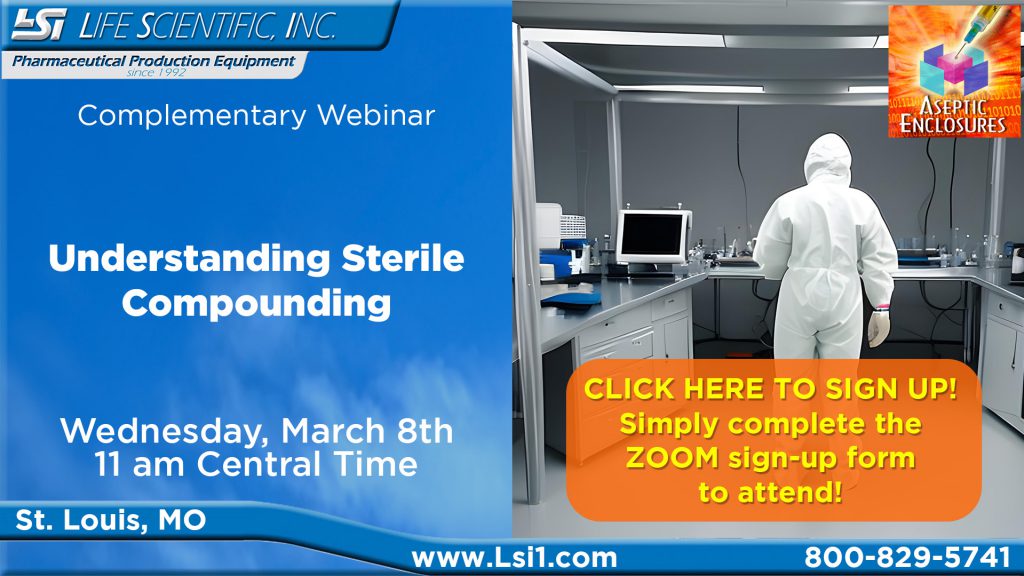Over the course of the past few years, Aseptic Enclosures were called upon to come up with a solution that will provide ISO class 5 conditions for tablet compounding. This was not a simple challenge to complete as there were several potential concerns in the process of tablet and pellet pressing. Yet we were able to deliver a Tablet Press Enclosure that puts the whole pressing process in aseptic containment.
The issues we had successfully overcome were:
- increasing safety of the pharmacist
- assuring sterility of the product
- limit particulate emissions and
- avoid risks for potential cross-contamination of products.
By now, we’ve supplied such custom solutions that were made to house different types and brand names of Tablet and Pellet Presses, which had led to having us develop a somewhat standardized Tablet and Pellet pressing enclosure capable of sustaining an ISO Class 5 environment conditions. We are always very cognizant of our client’s economic implications, so our solution is always to work with the equipment that you already have. Therefore, with minor adjustments, our Isolators can work with all brand names table top pellet presses including CSS, Stokes, Natoli, MesaLabs, Jinhe, CandyLand, EcVV among others.
Our Tablet Press Solution
Our end product is a solution with an integrated containment system that incorporates a containment primary engineering control (C-PEC), a secondary engineering control (C-SEC), and a containment ventilated enclosure (CVE) system. This is a derivative of the standard XLTC800 system that provides superior safety for both the pharmacist and the patient. Its capabilities come from its comprehensive protective barrier that is aseptically isolated, runs all operations under exhausted negative pressure, and incorporates strategic pressure differentials with superior HEPA filtration technology.
Our main focus is on containing the process of forming and coating the compounded tablets. The dust that is escaping when handling highly active products on tablet presses, can result in heavy contamination of the workplace. Operator safety plays a very important role, and OEL figures must be kept low. Economic aspects then become very important, as safe implementations can be expensive.
The direct compounding area (DCA) of our containment primary engineering control (C-PEC) is directly connected to our containment secondary engineering control (C-SEC). This C-SEC / prep chamber will maintain near 0 particulate, Iso class 5 conditions at all times, even during dynamic usage. The C-SEC prep chamber will run at negative pressure to the attached containment primary engineering control (C-PEC).
Because the C-SEC chamber is configured to run negative to the C-PEC, the risk of particulate ingress into the C-PEC is greatly reduced, especially when compared to open hoods in cleanrooms. Typical cleanroom configurations have anterooms that must run at positive pressure to the buffer room in order to maintain HD containment.
As verified by multiple microbial studies, the buffer room being negative to the anteroom creates serious particulate ingress risk, especially if a sink is located near the buffer room ingress. Our C-SEC prep chamber really is the heart of the aseptic quality improvements.
The C-SEC is designed to be the disinfection/prep/ wipe-down area for all products prior to being transferred into the direct compounding area (DCA) of the C-PEC. Our system enables product disinfection and wipe-down to occur in a largely unbreachable, nearly continuous, 0 particulate environment. The C-SEC is a chamber completely void of particulate generating humans.
Thus, our C-SEC prep chamber can facilitate far superior, disinfecting wipe-downs. The nature of our C-SEC design serves as a constant reminder of the disinfection requirement. Resultantly, C-SEC also greatly increases adherence to compliant disinfection procedures.
Directly attached to our C-SEC prep chamber is the CVE (Containment Ventilated Enclosure). This CVE chamber serves as the area for fully protected opening, staging, and storage of incoming hazardous drug materials. Unopened boxes from shipping and receiving that contain hazardous materials are transferred directly into our equipment through a sliding, accordion-style door.
These packages, typically tote bins, can then be opened from the safety of our isolated, negative pressure chamber. A variety of storage systems can be integrated into the CVE. Both refrigerated and ambient storage options are available. Once attached, they become part of the negative pressure, HEPA exhausted CVE system.
Exiting products and contaminated waste can safely be bagged, decontaminated, and brought out of the CVE chamber for proper transport or disposal. The CVE runs at a negative pressure to the secondary engineering control/prep chamber so that particulate ingress into the prep chamber is minimized.
These chambers also meet the Merriam-Webster definition of a room and can arguably be placed outside of a cleanroom.
To discuss your current tablet pressing woes, please fill out the contact form or write us on Linkedin and we’ll get back to you at our earliest convenience.



Thanks for the inspiration!
You are most welcome. Thanks for stopping by!!